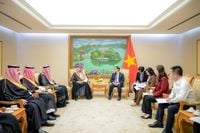In a move that underscores the growing economic and industrial ties between Saudi Arabia and Vietnam, Saudi Minister of Industry and Mineral Resources, Bandar bin Ibrahim Al-Khorayef, embarked on an official visit to Hanoi on September 29, 2025. The trip was marked by high-level meetings with Vietnamese officials and a comprehensive inspection of Saudi Arabia's fitness industry, reflecting a dual focus on international partnership and domestic sectoral growth.
Al-Khorayef’s visit began with a pivotal meeting with Vietnam’s Deputy Prime Minister, Boui Thaneh Soon, where the two leaders explored avenues for expanding economic collaboration, particularly in the fields of industry and mining. According to coverage by Akhbaar24, the dialogue emphasized the importance of empowering the private sector to seize mutual investment opportunities in these sectors, while also bolstering the role of the Saudi-Vietnamese Business Council. Vietnam, as it turns out, has become an increasingly significant destination for Saudi investments, with the total value now exceeding $1.92 billion across diverse sectors such as energy, industry, and technology.
The discussions did not stop at broad economic themes. Both sides delved into the potential for exchanging expertise and attracting investments in promising fields, including food industries and halal products. There was a clear emphasis on fostering cooperation in research, innovation, and advanced manufacturing technologies, with artificial intelligence highlighted as a key area of mutual interest. The Saudi delegation presented the Kingdom’s competitive advantages for industrial investment—its strategic location bridging three continents, abundant natural resources, competitive energy prices, and modern infrastructure, all of which make Saudi Arabia an enticing prospect for global investors.
During the same visit, Al-Khorayef held a bilateral meeting with Vietnam’s Minister of Industry and Trade, Nguyen Hong Dien. The two officials discussed expanding the horizons of their countries’ economic partnership and identifying reciprocal investment opportunities in advanced industrial sectors. This meeting reaffirmed the robust economic relationship between Saudi Arabia and Vietnam, a bond strengthened by the Saudi-Vietnamese Joint Committee established in 2006. Since then, the committee has played a crucial role in nurturing economic partnerships and supporting the growth of bilateral trade, which has surged from 9.58 billion Saudi Riyals in 2016 to 14.11 billion Riyals in 2024.
“The strength of the economic relationship between our countries is evident not just in the numbers, but in the depth of our cooperation across multiple sectors,” Al-Khorayef stated during the proceedings, as reported by Akhbaar24. The meetings also explored ways to enhance industrial collaboration, particularly in sectors like automotive manufacturing, food processing, metallurgy, and semiconductors. Both parties underscored the importance of knowledge exchange, technology transfer, and workforce development in these burgeoning industries.
But Al-Khorayef’s agenda in Hanoi extended beyond international diplomacy. Accompanied by Boui Thaneh Soon, who also serves as President of the Saudi Federation for Fitness, the minister conducted an inspection tour to assess the progress of Saudi Arabia’s fitness industry and its integration with the federation’s initiatives. This inspection focused on the interplay between private sector entities, government bodies, and the federation in fostering the growth of fitness and related activities throughout the Kingdom.
The Saudi Federation for Fitness, established in 2006, has played a pivotal role in promoting the development of the fitness industry nationwide. According to official figures, the federation currently manages investments exceeding $1.92 million and supervises a substantial network of fitness, sports, and technical clubs. The federation’s efforts have borne fruit: the number of fitness clubs has grown from 9.58 million Riyals in 2016 to 14.11 million Riyals in 2024, reflecting a significant expansion in both scale and scope.
The inspection tour covered a range of private clubs, government entities, and public sports clubs, all with the aim of strengthening cooperation among these various stakeholders. The overarching goal? To further develop the fitness sector and its associated sports activities, ensuring that Saudi Arabia’s citizens have access to world-class facilities and programs. Al-Khorayef emphasized the importance of this integration, noting that “the progress of the fitness sector depends on seamless collaboration between private and public actors, as well as the federation’s strategic vision.”
The federation’s mandate is not just about physical infrastructure, though. It also encompasses the nurturing of human capital and the adoption of innovative technologies in sports and fitness. The focus on advanced manufacturing, artificial intelligence, and technical expertise is seen as crucial for positioning Saudi Arabia at the forefront of the global fitness and sports industry. As Akhbaar24 reported, the inspection aimed to identify new opportunities for investment, technology transfer, and capacity building—echoing the themes discussed in the minister’s meetings with Vietnamese officials.
Observers note that the federation’s growth parallels broader economic trends in Saudi Arabia, where diversification away from oil and towards knowledge-based sectors has become a strategic priority. The leap in fitness club numbers and investments over the past decade is a testament to the Kingdom’s commitment to fostering healthy lifestyles and modernizing its service industries. Moreover, the integration of advanced technology and international best practices is expected to further enhance the sector’s competitiveness both regionally and globally.
Throughout the visit, Al-Khorayef was joined by a high-level delegation, including the Saudi ambassador to Vietnam, Mohammed Dahlawi, and the CEO of the National Center for Industrial Development, Saleh Al-Sulami. Their presence underscored the importance of these discussions, not only for bilateral relations but also for the ongoing transformation of Saudi Arabia’s industrial and fitness landscapes.
In summary, Al-Khorayef’s trip to Vietnam served as a powerful reminder of how international cooperation and domestic development can go hand in hand. Whether it’s fostering joint ventures with Vietnamese partners or nurturing the fitness aspirations of Saudi citizens, the message was clear: progress depends on partnership, innovation, and a willingness to embrace new opportunities. As both countries look to the future, the foundations laid during this visit are likely to yield dividends for years to come.

